Project Antohi House came with a number of challenges for the architect, designer and builder. The owner, Claudiu Antohi, wanted first and foremost a passive house on a wooden structure, secluded from the city and with an energy generation system. The house with a more special architecture was to have a fireplace, a living room high up to the roof, rooms upstairs with cantilevered floors, a wall without a ceiling, a staircase floating, sliding door to the outside, photovoltaic tiles on the roof. Each of them posed their own challenges. The very good and continuous collaboration between all parties involved meant that these challenges were resolved so that the site could run smoothly. We now all agree that the project Antohi House is a very successful one.
About the project we talked to Octavian Timu from Creative Engineering and Vlad Liteanu-Voinescu, Litarhthe designer and builder of the house, during the public presentation at nZEB Week in Cluj. The video is at the end of the article.
19th-century central wall, fireplace and beam
Inside, the challenges were many and varied. The house is composed of three parts, two side parts on two levels and a vertically open central area. The roof basically connects the ends to the central area. In the central part there is a partition wall separating the living room from the staircase to the first floor. As the area is vertically open, the wall does not meet the ceiling but a beam that appears to support it. The beam, salvaged from a disused 19th-century 19th-century stable in Brasov, had to be incorporated into the project. The wall also had to be attached to the beam without spoiling its aesthetics. The clever solutions found by the builder and designer solved both situations and the owner's wishes could be respected.
But the main challenge was the fireplace that was positioned on the living room wall. Its exhaust system could affect the interior ventilation and thus not reach passive house parameters. Therefore a certified passive house fireplace with a special exhaust system was installed. The fireplace also required adaptations to the floor-mounted insulation so that its weight was not affected.
On the other side of the wall will be the staircase to the first floor. It's designed to look like it's floating. Special places have been provided on the wall to hold the steps on one side, and a wall comes down from the upstairs to hold the other side of the steps. The wall does not reach to the floor and so the stair seems to float.
Upstairs - the console bedroom
Upstairs are the bedrooms. The first of them is cantilevered, meaning the floor does not rest against a wall on the side facing the stairs. The forces that should have discharged on the supporting wall were transferred to other walls. Octav resolved the situation at the design stage by fitting bracing to the wooden walls of the structure and providing additional bracing on the exterior retaining walls. The ongoing collaboration between the designer and the builder meant that the Litarh team had a good understanding of how to deal with this situation on site and it was resolved.
The outside door challenge - atypical shapes and sizes for a passive house
Very important in achieving passive house parameters are windows and exterior doors. The big test was a 5m sliding door. Sliding doors are sometimes problematic because the closing fails to seal. The door at the Antohi house was made by Danprod and is Passive House certified. Danprod also made the arched door for which installation issues were resolved by the Litarh team on site.
The vapor barrier was installed at the construction site to ensure continuity and integrity. Latest leak test showed a number of air changes n50=0.578/h (number of air changes/hour at a pressure of 50 Pascal), below the permissible limit of 0.6. But in the meantime, improvements have been made at the construction site that will further reduce the number of air changes.
Although fewer than on the inside, there were challenges on the outside too
Antohi house is on wooden structure with prefabricated walls. The walls were made in the factory and filled inside with 20 cm of basaltic wool insulation. The remaining 20 cm, necessary to reach the passive house standard, was provided by the external wood fiber envelope.
On the outside, the ventilated wooden facade on the first floor had to be matched with the thermosystem on the ground floor. In order for the ventilation to work properly, the design was made so that the ventilated facade protruded a few millimeters. This provided the necessary ventilation and ensured that water ran off the wood without stagnation at the end. It is the way to protect the wood from mold and rot.
To keep the sun from heating up the walls of the house too much on hot summer days, a sunshade was mounted on the most exposed area. The challenge was securing it so that the vapor barrier was not breached. The choice was for light wall fastening with very good subsequent insulation to prevent any seepage, coupled with roof anchoring.
The plinth will be finished with stone to imitate old peasant houses. In order to avoid infiltration, the plinth side of the house will be clad with DHF wood fiber board for insulation instead of Aqua Panel, a special material for stone cladding.
The first house in Romania to install photovoltaic tiles
The roof of the Antohi house is pitched at 38°. Solar tiles were installed on the south-facing side Terran GeneronThe rest are ordinary concrete tiles, also from Terran. There are 400 photovoltaic tiles, each with an output of 15 W, giving an installed power of 6 kW. They are ordinary concrete tiles on top of which the photovoltaic cell has been factory-mounted. The conventional tiles are coated with black polyurethane paint which is UV and weather resistant, including hail.
The thermal insulation of the roof was done with 30 cm of basaltic wool mounted between the rafters and another 10 cm mounted on top. Over this was fixed the DVD astere, a special construction MDF. As the house was intended to be roofed with photovoltaic tiles there needed to be more ventilation space underneath to allow cooling. The manufacturer recommended a minimum of 75 mm. For safety, the builder made this space a minimum of 80 mm, as this is also the space through which the cables that connect the tiles to the storage batteries run.
Antohi House proves that you don't have to give up the dream of having a passive house with special architecture. The key is to find teams ready and willing to solve any challenge. Communication between them is essential.




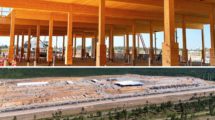


















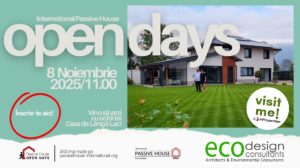


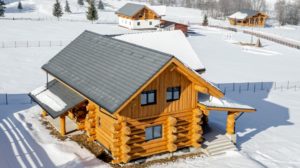
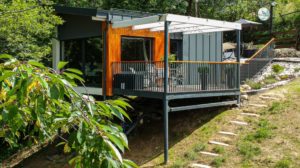


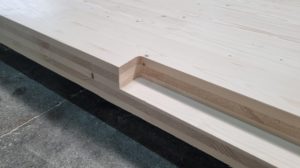
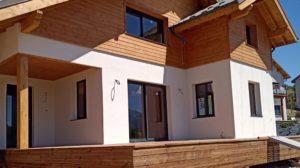



Add comment